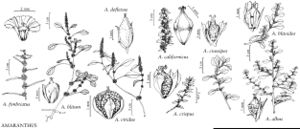Amaranthus viridis
Sp. Pl. ed. 2, 2: 1405. 1763.
Plants annual, sometimes short-lived perennial in tropics and subtropics, glabrous. Stems erect, simple or with lateral branches (especially distally), 0.2–1 m. Leaves: petiole 1/2–11/2 as long as blade; blade rhombic-ovate or ovate, 1–7 × 0.5–5 cm, base rounded, cuneate, or attenuate, margins entire, plane, apex obtuse, rounded, or emarginate, mucronate. Inflorescences slender spikes aggregated into elongate terminal panicles, also from distal axils, green, leafless at least distally. Bracts of pistillate flowers ovate to lanceolate, 1 mm, shorter than tepals. Pistillate flowers: tepals 3, narrowly elliptic, obovate-elliptic or spatulate, not clawed, ± equal, 1.2–1.7 mm, apex rounded or nearly acute, mucronate or not; style branches erect; stigmas 3. Staminate flowers inconspicuous, mostly at tips of inflorescences; tepals 3; stamens 3. Utricles ovoid to compressed-ovoid, 1–1.6 mm, equaling or slightly exceeding tepals, prominently or faintly rugose, indehiscent. Seeds black or dark brown, subglobose to thick-lenticular, 1 mm diam., minutely punctulate, rather dull.
Phenology: Flowering summer–fall.
Habitat: Fields, railroads, lawns, gardens, waste areas, other disturbed habitats
Elevation: 0-1000 m
Distribution
Introduced; Ala., Ariz., Ark., Fla., Ga., La., Mass., Mich., Miss., N.Mex., N.Y., N.C., Okla., Pa., S.C., Tenn., Tex., Va., native to South America, introduced in tropical and subtropical regions worldwide.
Discussion
Selected References
None.
